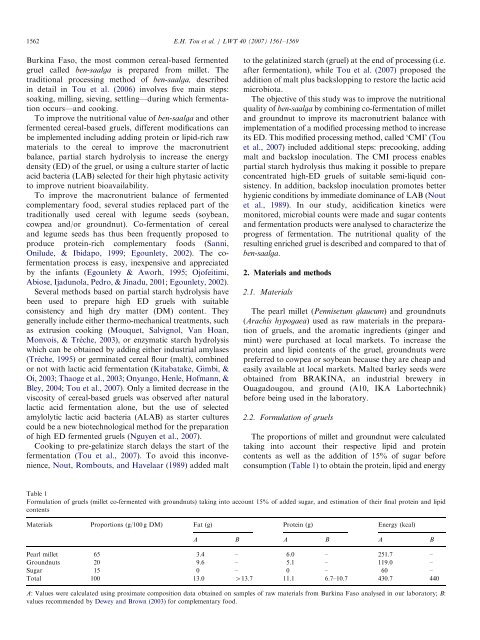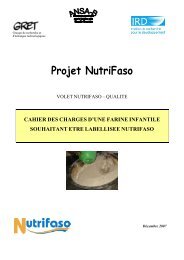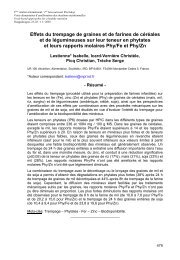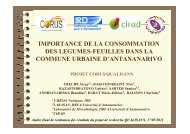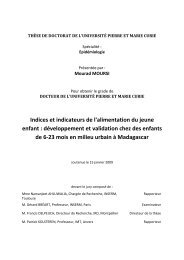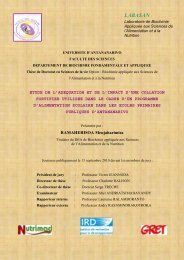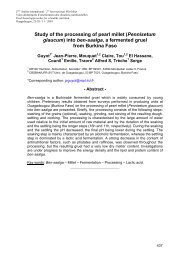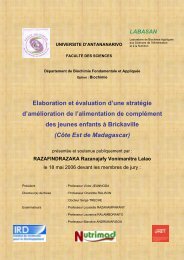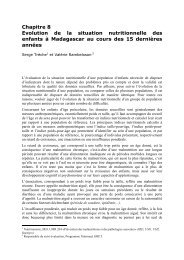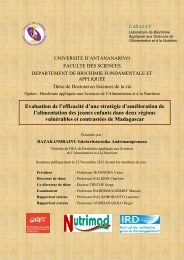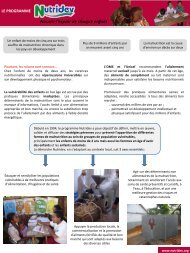THESE UNIQUE El Hassane Kéhien-Piho TOU - Nutridev
THESE UNIQUE El Hassane Kéhien-Piho TOU - Nutridev
THESE UNIQUE El Hassane Kéhien-Piho TOU - Nutridev
You also want an ePaper? Increase the reach of your titles
YUMPU automatically turns print PDFs into web optimized ePapers that Google loves.
1562<br />
ARTICLE IN PRESS<br />
E.H. Tou et al. / LWT 40 (2007) 1561–1569<br />
Burkina Faso, the most common cereal-based fermented<br />
gruel called ben-saalga is prepared from millet. The<br />
traditional processing method of ben-saalga, described<br />
in detail in Tou et al. (2006) involves five main steps:<br />
soaking, milling, sieving, settling—during which fermentation<br />
occurs—and cooking.<br />
To improve the nutritional value of ben-saalga and other<br />
fermented cereal-based gruels, different modifications can<br />
be implemented including adding protein or lipid-rich raw<br />
materials to the cereal to improve the macronutrient<br />
balance, partial starch hydrolysis to increase the energy<br />
density (ED) of the gruel, or using a culture starter of lactic<br />
acid bacteria (LAB) selected for their high phytasic activity<br />
to improve nutrient bioavailability.<br />
To improve the macronutrient balance of fermented<br />
complementary food, several studies replaced part of the<br />
traditionally used cereal with legume seeds (soybean,<br />
cowpea and/or groundnut). Co-fermentation of cereal<br />
and legume seeds has thus been frequently proposed to<br />
produce protein-rich complementary foods (Sanni,<br />
Onilude, & Ibidapo, 1999; Egounlety, 2002). The cofermentation<br />
process is easy, inexpensive and appreciated<br />
by the infants (Egounlety & Aworh, 1995; Ojofeitimi,<br />
Abiose, Ijadunola, Pedro, & Jinadu, 2001; Egounlety, 2002).<br />
Several methods based on partial starch hydrolysis have<br />
been used to prepare high ED gruels with suitable<br />
consistency and high dry matter (DM) content. They<br />
generally include either thermo-mechanical treatments, such<br />
as extrusion cooking (Mouquet, Salvignol, Van Hoan,<br />
Monvois, & Tre` che, 2003), or enzymatic starch hydrolysis<br />
which can be obtained by adding either industrial amylases<br />
(Trèche, 1995) or germinated cereal flour (malt), combined<br />
or not with lactic acid fermentation (Kitabatake, Gimbi, &<br />
Oi, 2003; Thaoge et al., 2003; Onyango, Henle, Hofmann, &<br />
Bley, 2004; Tou et al., 2007). Only a limited decrease in the<br />
viscosity of cereal-based gruels was observed after natural<br />
lactic acid fermentation alone, but the use of selected<br />
amylolytic lactic acid bacteria (ALAB) as starter cultures<br />
could be a new biotechnological method for the preparation<br />
of high ED fermented gruels (Nguyen et al., 2007).<br />
Cooking to pre-gelatinize starch delays the start of the<br />
fermentation (Tou et al., 2007). To avoid this inconvenience,<br />
Nout, Rombouts, and Havelaar (1989) added malt<br />
to the gelatinized starch (gruel) at the end of processing (i.e.<br />
after fermentation), while Tou et al. (2007) proposed the<br />
addition of malt plus backslopping to restore the lactic acid<br />
microbiota.<br />
The objective of this study was to improve the nutritional<br />
quality of ben-saalga by combining co-fermentation of millet<br />
and groundnut to improve its macronutrient balance with<br />
implementation of a modified processing method to increase<br />
its ED. This modified processing method, called ‘CMI’ (Tou<br />
et al., 2007) included additional steps: precooking, adding<br />
malt and backslop inoculation. The CMI process enables<br />
partial starch hydrolysis thus making it possible to prepare<br />
concentrated high-ED gruels of suitable semi-liquid consistency.<br />
In addition, backslop inoculation promotes better<br />
hygienic conditions by immediate dominance of LAB (Nout<br />
et al., 1989). In our study, acidification kinetics were<br />
monitored, microbial counts were made and sugar contents<br />
and fermentation products were analysed to characterize the<br />
progress of fermentation. The nutritional quality of the<br />
resulting enriched gruel is described and compared to that of<br />
ben-saalga.<br />
2. Materials and methods<br />
2.1. Materials<br />
The pearl millet (Pennisetum glaucum) and groundnuts<br />
(Arachis hypogaea) used as raw materials in the preparation<br />
of gruels, and the aromatic ingredients (ginger and<br />
mint) were purchased at local markets. To increase the<br />
protein and lipid contents of the gruel, groundnuts were<br />
preferred to cowpea or soybean because they are cheap and<br />
easily available at local markets. Malted barley seeds were<br />
obtained from BRAKINA, an industrial brewery in<br />
Ouagadougou, and ground (A10, IKA Labortechnik)<br />
before being used in the laboratory.<br />
2.2. Formulation of gruels<br />
The proportions of millet and groundnut were calculated<br />
taking into account their respective lipid and protein<br />
contents as well as the addition of 15% of sugar before<br />
consumption (Table 1) to obtain the protein, lipid and energy<br />
Table 1<br />
Formulation of gruels (millet co-fermented with groundnuts) taking into account 15% of added sugar, and estimation of their final protein and lipid<br />
contents<br />
Materials Proportions (g/100 g DM) Fat (g) Protein (g) Energy (kcal)<br />
A B A B A B<br />
Pearl millet 65 3.4 – 6.0 – 251.7 –<br />
Groundnuts 20 9.6 – 5.1 – 119.0 –<br />
Sugar 15 0 – 0 – 60 –<br />
Total 100 13.0 413.7 11.1 6.7–10.7 430.7 440<br />
A: Values were calculated using proximate composition data obtained on samples of raw materials from Burkina Faso analysed in our laboratory; B:<br />
values recommended by Dewey and Brown (2003) for complementary food.


